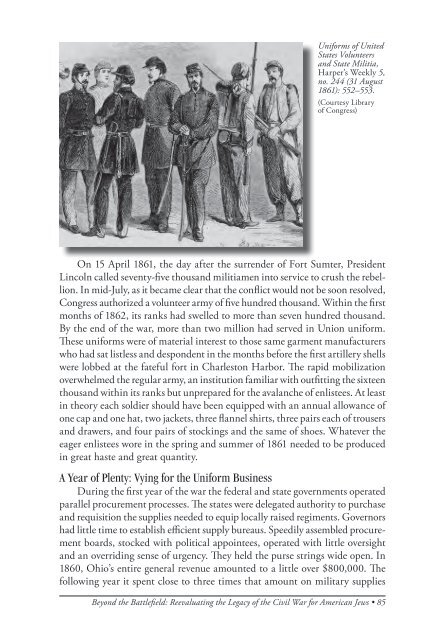American Jewish Archives Journal, Volume 64, Numbers 1 & 2
American Jewish Archives Journal, Volume 64, Numbers 1 & 2
American Jewish Archives Journal, Volume 64, Numbers 1 & 2
Create successful ePaper yourself
Turn your PDF publications into a flip-book with our unique Google optimized e-Paper software.
Uniforms of United<br />
States Volunteers<br />
and State Militia,<br />
Harper’s Weekly 5,<br />
no. 244 (31 August<br />
1861): 552–553.<br />
(Courtesy Library<br />
of Congress)<br />
On 15 April 1861, the day after the surrender of Fort Sumter, President<br />
Lincoln called seventy-five thousand militiamen into service to crush the rebellion.<br />
In mid-July, as it became clear that the conflict would not be soon resolved,<br />
Congress authorized a volunteer army of five hundred thousand. Within the first<br />
months of 1862, its ranks had swelled to more than seven hundred thousand.<br />
By the end of the war, more than two million had served in Union uniform.<br />
These uniforms were of material interest to those same garment manufacturers<br />
who had sat listless and despondent in the months before the first artillery shells<br />
were lobbed at the fateful fort in Charleston Harbor. The rapid mobilization<br />
overwhelmed the regular army, an institution familiar with outfitting the sixteen<br />
thousand within its ranks but unprepared for the avalanche of enlistees. At least<br />
in theory each soldier should have been equipped with an annual allowance of<br />
one cap and one hat, two jackets, three flannel shirts, three pairs each of trousers<br />
and drawers, and four pairs of stockings and the same of shoes. Whatever the<br />
eager enlistees wore in the spring and summer of 1861 needed to be produced<br />
in great haste and great quantity.<br />
A Year of Plenty: Vying for the Uniform Business<br />
During the first year of the war the federal and state governments operated<br />
parallel procurement processes. The states were delegated authority to purchase<br />
and requisition the supplies needed to equip locally raised regiments. Governors<br />
had little time to establish efficient supply bureaus. Speedily assembled procurement<br />
boards, stocked with political appointees, operated with little oversight<br />
and an overriding sense of urgency. They held the purse strings wide open. In<br />
1860, Ohio’s entire general revenue amounted to a little over $800,000. The<br />
following year it spent close to three times that amount on military supplies<br />
Beyond the Battlefield: Reevaluating the Legacy of the Civil War for <strong>American</strong> Jews • 85
















